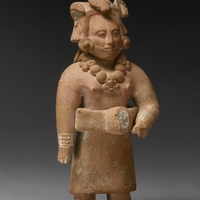[Untitled]
Item
-
Identifier
-
TP.2022.J.02
-
title
-
Figurine of a Female Ballplayer
-
name
-
Unknown
-
date created
-
ca. 600–900 CE
-
area
-
8 x 3.4 x 2.9 in (20.3 x 9.8 x 7.3 cm)
-
description
-
"This Jaina-style figurine is extremely unusual, as it depicts a female ballplayer. Although figurines of female ballplayers are common in Postclassic Huastec art, this may be one of the only known figurines of a female ballplayer from the ancient Maya world.
Although her face is indistinguishable from faces of male figurines (compare, for instance, to the seated male figurine 1985.640), the clear depiction of small breasts and nipples clearly identify her as a woman. She also wears the ankle-length skirt characteristic of women, instead of the knee-length kilt and loincloth flap worn by men. Her hair, cut to reveal a high forehead, is arranged in an elaborate coiffure, tied at the back and decorated at the front with three round, tasseled ornaments. Her necklace is nearly identical to that worn by another female figurine in the DAM's collection (1969.333), though here it lacks a second strand.
Around her waist is a u-shaped belt scholars refer to as a ""yoke,"" which identifies her clearly as a ballplayer (see 1991.500 for a stone yoke from Veracruz). The same element of ballplaying gear is slung over the shoulder of another figurine in the DAM's collection (1986.617). This thick, padded belt protected players' torsos and internal organs from injuries related to the heavy rubber ball used in the ballgame. The element (now broken) that decorates the front of this yoke may have been what scholars call an ""hacha,"" a narrow, axe-shaped element (see 1971.413, 1982.189, and 1985.395 for examples of stone hachas).
The ballgame in the ancient Maya world was a highly ritualized athletic contest replete with solar and agricultural metaphors. Associated with human sacrifice by decapitation and undertaken in order to ensure the continuation of cosmic cycles (including the rising of the sun and the growth of agricultural crops), this game is most frequently depicted as a male sport in Maya art. The reasons behind this representation of a female player remain enigmatic. It is possible the figurine represents a female participant in the rituals surrounding the ballgame rather than an actual ballplayer, or it may provide important evidence that women did participate in the ballgame at times. Regardless, the rarity of the subject indicates this figurine is deeply significant and deserves further, focused study."
—Lucia R. Henderson, Denver Art Museum, 2016
-
Access Rights
-
Gift of Mr. William I. Lee to the Denver Art Museum.
 TP-2022-J-02
TP-2022-J-02
